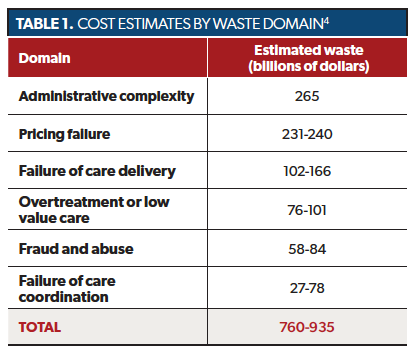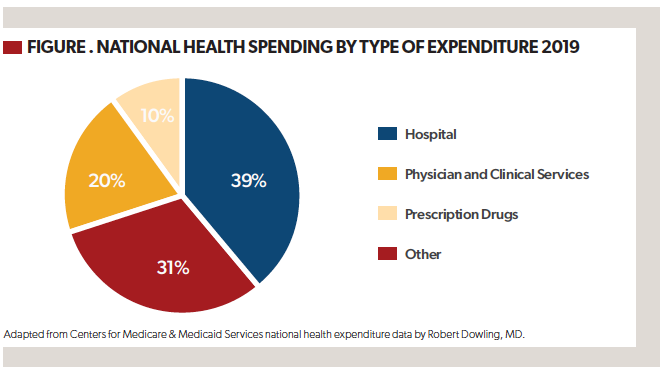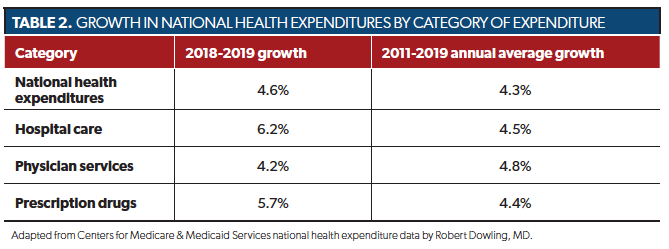Article
What can be learned from CMS data on health care spending?
Author(s):
Physician services see 4.8% annual average growth rate in the past 10 years.
Robert A. Dowling, MD

The United States spends more on health care than any other industrialized nation (almost 18% of gross domestic product [GDP]) and has the lowest rate of publicly insured citizens (36%), third highest rate of completely uninsured individuals (9%, slightly less than Mexico and Costa Rica), and lowest life expectancy (78.6 years). Much of our national political conversation has been dominated for decades by issues related to health care affordability and coverage. The Medicare Modernization Act (2003), Patient Protection and Affordable Care Act (2009), and Medicare Access and CHIP Reauthorization Act of 2015 are examples of laws that have their basis in reducing the cost and improving the value of health care in our country. Government regulations implementing these laws have had a direct effect on patients (eg, increased access for millions) and providers of care (eg, decreased reimbursement and increased complexity). Yet health care in the United States is expensive and getting more expensive by any measure. It is important for practicing physicians on the front lines of care delivery to have a passing knowledge of the cost of health care from a larger perspective than just reimbursement to their practice. The Centers for Medicare & Medicaid Services released their 2019 data on National Health Expenditures, along with the article “National Health Care Spending in 2019: Steady Growth for the Fourth Consecutive Year.”1,2 This article contains a summary of the key findings in a primer for the practicing urologist.
Spending on health care in the United States reached $3.8 trillion in 2019: $11,582 per person, or 17.7% (relatively unchanged over 4 years) of the US GDP. For context, health care expenditures in this country are usually compared with other economically developed peer countries. Although our delivery systems are significantly different, it is possible to compare costs and in some cases outcomes. The United States leads all 36 peer countries in health care spending as a percentage of GDP, about twice the average, according to the Organisation for Economic Co-operation and Development (OECD).3 US spending per capita is more than 2.5 times higher than the OECD average of $4000 US$. Growth in US spending was stable from last year at 4.6% yet almost twice the average rate of growth in OECD countries over the past 5 years of data available (2.4%). The OECD has robust data on quality and outcomes of care, access to care, health status, and more—the United States is below the OECD average in many of these domains. This forms the basis of arguments by policy makers in our country that the United States is not getting demonstrably better value for the dollars spent on health care compared with peer countries.
Zero in on the waste
In a 2019 published review of the literature, the authors concluded that the cost of waste in the US health care system is between $760 billion and $935 billion, or about 25% of all spending.4 There were 6 categories of waste identified (Table 1). In order of contribution to waste, they were as follows: administrative complexity (billing and coding waste, physician time spent reporting on quality measures), pricing failure, failure of care delivery (lack of preventive practices, hospital acquired events, clinician inefficiency [variability in care]), overtreatment or low-value care, fraud and abuse, and failure of care coordination. Nevertheless, the same authors concluded that targeted interventions in each of these domains would likely return only 25% of the waste, illustrating the complexity of our system and perhaps explaining why we don’t hear more about this beyond fraud and abuse.

The driver
To understand what is driving growth in spending in US health care, it is important to understand the major categories of spending as they have different growth rates. Hospital care (31%), physician services (20%), and retail prescription drugs (10%) are the major cost components and together make up 61% of national health expenditures (Figure). Growth in hospital spending in 2019 was the highest of any spending category, at 6.2%; prescription drug spending rose 5.7%; and spending on physician services rose 4.2%. In the past 10 years, overall annual growth has averaged 4.3%; hospital care growth, 4.5%; and prescription drug growth, 4.4% (Table 2). Physician services have grown at the highest annual average rate in the past 10 years—4.8%.

The most important factor is not the effect of an aging population or increase in prices but the use and intensity of those services, according to the report. This finding is cited as evidence that our fee-for-service model is still driving significant growth in spending and fuels the relentless pressure to transition to “value-based care.”
Private health insurance remains the largest source of funds for paying health care bills. It accounted for 33% of spending in 2019 and grew 3.7% over 2018. Medicare is the second largest source, accounting for 22% of spending. Medicare spending had its highest growth rate in the past 10 years, at 6.7%. Finally, out-of-pocket costs accounted for 11% of spending in 2019 and grew 4.6% over the previous year—also the highest rate of growth in the past 10 years. The source of funds for physician services in 2019 is distributed differently from overall health spending (Figure 4): out of pocket was 8%, private health insurance was 42%, and Medicare was 32%. Again, Medicare spending had its highest growth rate in 10 years in this category at 9%.

Bottom line: So what does this mean for your patients, your practice, and you? First, health care insurance, delivery, and payment policies will probably continue to dominate the conversation because health care is expensive and touches almost everyone in the United States. Urologists should have a working knowledge of these costs and their relevance to their patient population.

Second, because growth in spending on physician services is significant and appears to be largely driven by increased utilization, policy makers will continue to scrutinize this category of spending and attempt to identify opportunities to slow that growth. This concern is punctuated by the near double-digit growth in Medicare spending on physician services in 2019 and supports the case to shift from fee-for-service to fee-for-value payment models like the Merit-based Incentive Payment System and Medicare Shared Savings Program. Urologists should have a detailed understanding of their payer mix and follow the national conversation about insurance and Medicare reform in proportion and to the extent that their livelihood and patient populations are linked to policy decisions.
Finally, behind almost every large category of health care expenditure is a physician order. According to some estimates, 80% of overall health care costs result from the patient-care decisions that physicians make, yet surveys of physicians have shown that only a third feel that they have a major responsibility to control costs.5 This inconsistency reflects the dual role of physicians and the potential conflict of treating individual patients while collectively shepherding health care resources. It is only by understanding the cost drivers of health care that physicians, including urologists, can responsibly fill this dual role.
References
1. Centers for Medicare & Medicaid Services. National Health Expenditures 2019 Highlights. Accessed April 12, 2021. https://www.cms.gov/files/document/highlights.pdf
2. Martin AB, Hartman M, Lassman D, Catlin A. National health care spending in 2019: steady growth for the fourth consecutive year. Health Aff (Millwood). 2021;40(1):14-24. doi:10.1377/hlthaff.2020.02022
3. Organisation for Economic Co-operation and Development (OECD) data. OECD iLibrary. Accessed April 12, 2021. https://www.oecd-ilibrary.org/social-issues-migration-health/health-at-a-glance_19991312
4. Shrank WL, Rogstad TL, Parekh N. Waste in the US health care system. JAMA. 2019;322(15):1501-1509. doi:10.1001/jama.2019.13978
5. Tilburt JC, Wynia MK, Sheeler RD, et al. Views of US physicians about controlling health care costs. JAMA. 2013;310(4):380-388. doi:10.1001/jama.2013.8278

















